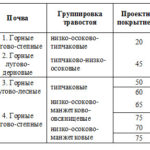UDC 581.552+504.732; 504.7+470.67
Kessel D.S., Abdurakhmanova Z.I., Shchukina K.V., Gadzhiataev M.G. COENOFLORA OF BIRCH AND PINE FORESTS OF THE GUNIB PLATEAU (DAGESTAN) // Arid ecosystems. 2022. V.28. № 3 (92). P. 45-52. | PDF
The results of the analysis and comparison of the coenoflora of birch (Betula litwinowii Doluch., B. raddeana Trautv) and pine (Pinus kochiana Klotsch ex G. Koch.) forests of the Gunib plateau (Inland mountain limestone Dagestan) are presented. The forests on the Gunib plateau are confined to the northern, north-eastern and north-western slopes, they occur at altitudes of 1400 — 2170 m above sea level. The analysis was carried out on the basis of field research materials 2011-2013, 2018-2020 — 53 standard geobotanical descriptions. When collecting the material, the task was to reflect as much as possible the diversity of communities of birch and pine forests of the Gunib plateau.
The species composition of vascular plants of birch (251 species) and pine (226 species) forests was revealed. The spectra of the leading families of both coenoflora were compared. Both cenoflora belong to Rosaceae-type that is characteristic of the Central European group of flora. The leading 6 families account for 50% of the cenoflora species of birch and pine forests (129 and 113 species, respectively). 130 species are common to communities of birch and pine forests.
The species composition of dominants and codominants of the grass-shrub layer of birch and pine forests is analyzed. Species that play a significant role in the communities of only one of these formations have been identified, despite the fact that both formations occupy similar ecotopes and in most cases the same species are dominant and co-dominant of the grass-shrub layer in these communities.
The ratio of florocenoelements in the grass-shrub layer of birch and pine forests is determined. A greater number of species belonging to the forest cenotype grow in birch forests: 29% of forest species from the total number of species in birch forests and 21% in pine forests. There are fewer species characteristic of meadows, including subalpine and alpine, in birch (57%) forests than in pine (64%). Also, fewer ruderal species were found in birch forests (2.5%) than in pine forests (4.5%). One of the reasons for the revealed ratio of species belonging to forest, meadow and ruderal florocenotypes in the coenoflora of birch and pine forests, in our opinion, is the peculiarities of the renewal of these forest-forming species on the Gunib plateau.
The analysis made it possible to identify differences in the habitats occupied by birch and pine forests at extreme values of light and moisture availability.
Keywords: Betula litwinowii, Betula raddeana, Pinus kochiana, vegetation, birch forests, pine forests, Gunib plateau, Dagestan.
Aknowledgements. The authors are grateful for the help in conducting field research of the Director of the Mining Botanical Garden of the OP of the Russian Academy of Sciences, Doctor of Biological Sciences, Professor Z.M. Asadulaev, Head of the Ecological and Botanical station «Pyatigorsk» of the BIN RAS, Candidate of Biological Sciences, D.S. Shilnikov, N.S.W. of the Laboratory of General Geobotany of the BIN RAS N.S. Liksakova.
Financing. The work was carried out within the framework of the planned theme of the V.L. Komarov Botanical Institute of the Russian Academy of Sciences «Vegetation of European Russia and Northern Asia: diversity, dynamics, principles of organization» (No. 121032500047-1) and the planned theme of the Laboratory of Introduction and Genetic Resources of Woody Plants of the Mountain Botanical Garden of the Russian Academy of Sciences «Structural and functional features of plant communities with populations of rare and resource tree species (on the example of the Eastern Caucasus)» (No. AAAAA-A19-119020890099-4).
DOI: 10.24412/1993-3916-2022-3-45-52







